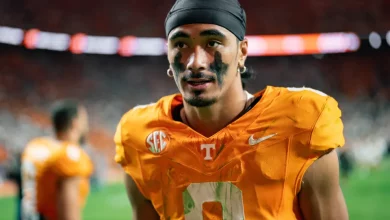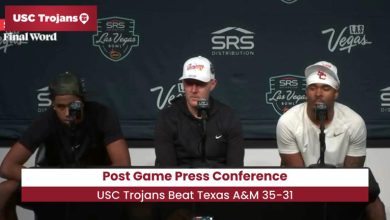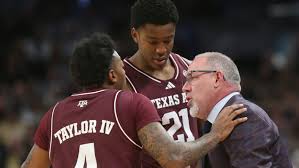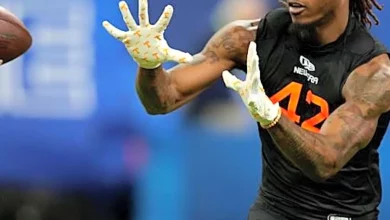The Baltimore Ravens add cap space and modify Michael Pierce’s retirement.

In the ever-evolving landscape of the NFL, teams constantly look for ways to manage their rosters, free up cap space, and position themselves for success in the coming seasons. One of the more intriguing and unexpected moves in recent weeks has come from the Baltimore Ravens, who, in a series of roster decisions, have found a way to both add cap space and modify the retirement of defensive lineman Michael Pierce, a move that has significant implications for the team’s immediate future.
This development is noteworthy for a variety of reasons, but perhaps most importantly, it marks the intersection of financial strategy and roster management in the modern NFL. By tweaking the terms of Pierce’s retirement, the Ravens are effectively buying themselves more flexibility and potentially shoring up one of the most important positions on their defense without taking a major hit to their salary cap. This decision—while it may not make the headlines in the way that big-name signings or trades do—has the potential to reshape the team’s outlook for the next few years, especially as they navigate the choppy waters of salary cap management.
The Ravens, historically one of the NFL’s most well-run organizations, have been diligent in managing their cap space, and this decision is just the latest example of their adept maneuvering. Let’s dive into the specifics of how this cap-saving move came to be, what it means for the Ravens moving forward, and why Michael Pierce’s modified retirement could have significant ripple effects for both the team and the player.
Understanding Michael Pierce’s Initial Departure and Retirement
To understand the full impact of this decision, we first need to look back at Michael Pierce’s career with the Baltimore Ravens and the circumstances surrounding his initial retirement.
Michael Pierce joined the Ravens as an undrafted free agent in 2016, and over the course of several seasons, he developed into one of the team’s most reliable defensive players. Known for his exceptional ability to stop the run, Pierce carved out a niche as one of the league’s most dominant nose tackles. His size (6’0”, 340 pounds) and his ability to clog up the middle of the defense made him a key cog in Baltimore’s defensive line rotation. While he may not have always garnered the same attention as some of the more high-profile defensive stars, his ability to take on double-teams and free up other defenders to make plays was invaluable to the Ravens’ success.
However, after spending several years in Baltimore, Pierce made the decision to sign a free-agent contract with the Minnesota Vikings in 2020. This move was seen as a significant blow to the Ravens, as Pierce had become a cornerstone of their defensive front. Nonetheless, the Ravens were forced to move on, and they signed a number of players to help fill the void left by Pierce’s departure.
The move to Minnesota, however, did not play out as Pierce had envisioned. He struggled with injuries during his tenure with the Vikings and was sidelined by a series of unfortunate circumstances. Then, in 2022, Pierce made the shocking decision to retire from football, citing health concerns and the toll that years of playing in the NFL had taken on his body.
For the Ravens, Pierce’s departure was bittersweet. While they had already moved on and restructured their defensive line in the wake of his free-agent signing, the player who had been a crucial part of their defense was now officially retired. This move created some financial clarity for the team, as they no longer had Pierce’s contract on the books.
However, it was not the end of Pierce’s connection with the Ravens, as events over the next year would prove.
The Cap Space Struggle and the Ravens’ Pursuit of Financial Flexibility
In the modern NFL, cap space is as much of a commodity as talent itself. Teams must continually balance their roster with the constraints of the salary cap, which places limitations on how much they can spend on players each season. For teams like the Ravens—who are perennially in contention but need to manage their finances carefully to remain competitive—cap space is a critical piece of the puzzle.
The Ravens, as of late 2023, were in a tight financial position. Their defense, though still formidable, needed some retooling. With several contracts for key players coming up for renewal, including quarterback Lamar Jackson’s new deal, the Ravens needed to find ways to both compete for a Super Bowl and preserve financial flexibility.
One area of particular focus was the defensive line. The Ravens had been solid up front, but they lacked a true difference-maker at the nose tackle position since Pierce’s departure. The team was hoping to find a way to address that need without blowing their cap space on an expensive free-agent addition. That’s when an unexpected solution arose: a modified retirement for Michael Pierce.
Modifying Pierce’s Retirement: A Cap-Saving Strategy
Here’s where the situation gets particularly interesting. In an unexpected move, the Ravens and Michael Pierce came to an agreement that allowed the player’s retirement to be altered in a way that benefited both sides. This agreement, which essentially reversed Pierce’s retirement and allowed him to return to the Ravens under a modified contract, was a strategic move that provided the Ravens with much-needed cap space.
From a financial perspective, this arrangement allowed the Ravens to place Pierce’s retirement on the “reserve/retired” list, freeing up cap space that would have otherwise been tied up in his contract. This move created an immediate financial benefit for the Ravens, who were able to allocate the savings to other areas of need on the roster, such as strengthening their secondary or re-signing some of their other free agents.
But it wasn’t just about the money. Pierce’s return, even in a modified capacity, could have a tangible impact on the field as well. The Ravens’ defense, known for its aggressive play and ability to disrupt offenses, had missed Pierce’s presence at the nose tackle position. While the team had managed to survive without him, they were never able to truly replace the space-eating, run-stuffing presence that Pierce provided. By bringing him back—even if it’s under a reduced capacity—the Ravens gain both financial flexibility and a potential key contributor to their defensive line.
Implications for Michael Pierce: A New Chapter in His Career
For Michael Pierce, the decision to modify his retirement is a significant moment in his career. After years of battling injuries and dealing with the physical toll of playing in the NFL, Pierce was at a crossroads. However, his return to the Ravens, even in a modified role, suggests that Pierce may have more to offer than previously thought.
At 30 years old, Pierce is no longer in the prime of his career, but he is still a valuable asset in a specific role. If he can stay healthy, Pierce’s experience and ability to clog up the middle of the defense could provide the Ravens with a much-needed boost in their efforts to defend against the run. The team has already shown that they are willing to take a risk on veterans with experience, and Pierce’s return could be seen as an opportunity to add depth to a unit that has become more dynamic in recent years.
While it’s unlikely that Pierce will be the dominant force he once was, his leadership and knowledge of the Ravens’ defensive system could prove invaluable. Furthermore, given the team’s current defensive lineup, Pierce may be able to contribute without being forced into a starting role. His ability to step in when needed could make him a perfect rotational player, giving the Ravens’ younger defensive linemen a mentor while also providing much-needed rest for the team’s star players.
Pierce’s return also has a psychological component. The Ravens have long been known for their culture of toughness and resilience, and bringing back a player like Pierce—who has a deep connection with the franchise—could further solidify the team’s identity. Players like Pierce are often the heart and soul of a defense, and having him back in the fold could be a rallying point for the entire defense.
The Future Outlook for the Ravens: Financial Flexibility and Defensive Depth
Looking ahead, the Ravens’ decision to modify Michael Pierce’s retirement and create cap space has wide-reaching implications for the team. This move, while subtle, demonstrates how the Ravens’ front office continues to operate with a long-term vision while simultaneously addressing the needs of the present.
The financial flexibility gained by modifying Pierce’s retirement will allow the Ravens to make additional moves down the line, whether it be re-signing current players, adding new talent, or even retooling their roster during the season if necessary. With the NFL’s salary cap always looming large, finding ways to manage cap space while remaining competitive is a crucial skill, and the Ravens have once again shown that they excel at it.
Defensively, the addition of Pierce—if he can stay healthy—could provide the team with the reinforcement they need in the interior. With the Ravens’ defense already featuring elite players like Roquan Smith and Marlon Humphrey, Pierce could fill the gap left by his own departure years ago, allowing the team to remain stout against the run while keeping their defense fresh for a deep playoff run.
A Shrewd Move in the Ravens’ Long-Term Strategy
The Baltimore Ravens have once again shown their ability to think ahead and make moves that will benefit both the present and future of the team. By modifying Michael Pierce’s retirement and freeing up cap space, the Ravens have positioned themselves to remain competitive in a tightly contested AFC North division while keeping an eye on future financial flexibility.
For Michael Pierce, his modified retirement offers a chance at redemption and perhaps a final opportunity to contribute to the team that originally gave him a chance in the NFL. Whether his role will be that of a mentor, a rotational player, or something more, only time will tell, but the Ravens have undoubtedly made a move that could pay dividends both on and off the field.
As the NFL continues to evolve, the Ravens remain one of the league’s most savvy and strategic organizations, constantly finding
ways to balance financial constraints with roster needs. This move is just the latest example of their successful long-term strategy—one that could very well lead to more success in the years to come.









